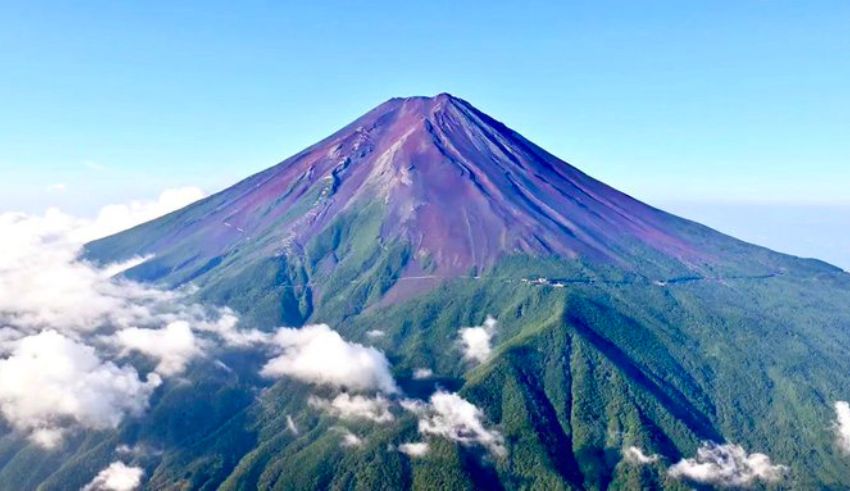

(C) Japan
Late October’s bare Mount Fuji, a symbol of resiliency and natural beauty, marks the first time in 130 years that its famous snowcap is absent far into autumn. Traditionally, this time of year would see the mountain’s peak covered with a fresh white covering, a symbol revered by the Japanese people as it is by the millions of visitors annually. But the past record for the most recent snowfall on October 26, established in 1955 and once more in 2016, has been broken, highlighting a concerning new reality: the natural cycles defining Fuji’s seasonal beauty are changing in response to increasing global temperatures.
Experts point to the delayed snowfall as a direct result of climate change, noting that Japan’s summer of 2024 was its hottest on record with temperatures hitting historic highs. Mount Fuji’s snowfall depends on cooling patterns, which have been interrupted by this extreme summer heat and unusually warm fall circumstances, therefore delaying its start every year. These changes are alarming markers of how local weather patterns are being changed by climate change influencing air cycles and hence harming ecosystems in hitherto unthinkable ways. The predicament of Mount Fuji reminds us that the forces released by a warming planet can compromise even famous vistas, apparently everlasting.
Mount Fuji has been particularly dear to Japanese people for ages. Celebrated in many works of art, from modern photography to historic woodblock prints, it represents peace, balance, and natural beauty. Respected as a spiritual site, Mount Fuji is seen as a source of inspiration and power; its snow-capped top represents purity and fortitude. But the rising frequency of snowless October may compromise the mountain’s reputation as Japan’s beloved “snowy peak.” Seeing Fuji without its recognizable white top is more than just a visual letdown for the Japanese people; it’s a frightening reminder that climate change is encroaching even into their most holy areas.
Delayed snow cover on Mount Fuji also affects the travel business for Japan. Although the summer climbing season has just closed, winter is a similarly crucial season drawing thousands of tourists ready to ski, snowboard, or just enjoy the snow-capped peak from a distance. Local hotels, equipment rentals, and tour companies mostly depend on this seasonal flow; the appeal of Fuji in winter is fundamental for their operations. The absence of snow and the possible decline in winter visitors could affect the economy of the area since the winter scene of the mountain attracts both Japanese visitors and foreign guests, therefore supporting local companies. Should climate change rob Fuji of its winter appeal, there may be long-lasting financial effects that force companies to rethink how they might adjust to a less predictable winter.
Although Mount Fuji’s snowless October would seem to be a distinctively Japanese worry, the underlying cause is a global one influencing ecosystems, climate patterns, and local populations all around. From the melting Himalayan glaciers to the declining snow cover of the Alps, rising global temperatures, record-breaking heat waves, and erratic seasonal changes are bringing similar circumstances everywhere. These disturbances affect local flora and fauna as well as natural resources, therefore compromising the ecological balance of whole areas. In many respects, Mount Fuji’s current snowless peak serves as a foreshadow of what many other sites could experience and emphasizes the need for immediate worldwide action to solve the climate problem.
Mount Fuji, one of the most well-known natural sites in the world, represents both national pride and a link to nature for Japan. Its snowless peak this October is a warning sign that the effects of climate change reach landscapes near people’s hearts and are fundamental to cultural identity, not only isolated glaciers or polar areas. The condition of Japan reflects a worldwide reality: if we are to save not just Mount Fuji but also many other natural beauties all around the planet by means of quick climate action. To lower carbon emissions, change toward sustainable habits, and assist in lessening the effects of climate change on ecosystems, group action is needed.
The snow delay of Mount Fuji reminds me strongly of what is at risk. This famous summit is closely related to Japan’s cultural legacy, natural beauty, even economic stability as well as the identity of many other countries connected to the terrain. The naked slopes of Mount Fuji this autumn inspire us all to understand the scope and seriousness of the global catastrophe. Protecting natural beauties like Fuji is about protecting the health, legacy, and natural balance that support human communities and enhance our shared experience on this world, not merely about safeguarding travel sites. Fuji’s snowless top should inspire us to become accountable and help to protect our planet for future generations.
OpenAI updated ChatGPT-4o to include its best text-to-image tools so free users can generate Studio Ghibli artwork by giving basic…
The stepping down of Piyush Gupta from the post of CEO of DBS Bank came after 15 years of leading…
The Delhi Directorate of Education releases 2025-26 marks for year-end tests in school levels 6 through 11. Online test data…
Singapore will further cement its status as an important basketball destination when it hosts three FIBA 3x3 events in 2026…
Jewel Section E, directed by Theodore Boborol and starring Ashtine Olviga as Jay-Jay Mariano, Andres Muhlach as Mark Keifer Watson,…
Cebu Pacific celebrates the delivery of its very first aircraft for 2025, the 459-seat Airbus A330neo, delivered at Ninoy Aquino…
This website uses cookies.
Read More